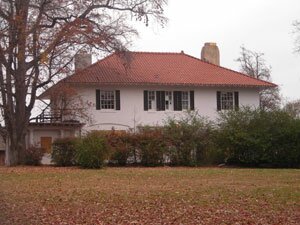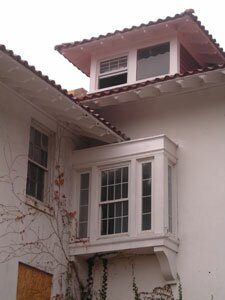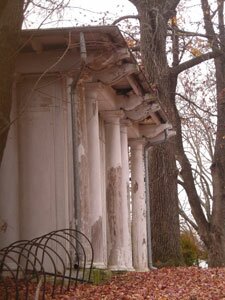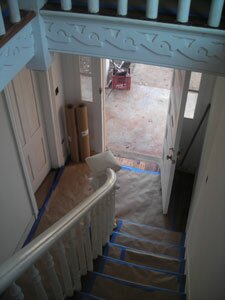ONARCHITECTURE- Demo dilemma: When is an old house worth saving?

The Jefferson Scholars Foundation recently applied for a demo permit to take down Beta House to make room for its new $21 million headquarters.
PHOTO BY DAVE MCNAIR
Like a patient on life support with a mysterious disease, the distinctive Compton House at 124 Maury Avenue, more commonly known as Beta House, has been awaiting a final diagnosis for months while those hoping for a cure have clashed with those wanting to pull the plug.
Preservationists have argued that the Beta House, designed by famed local architect Eugene Bradbury, is an architectural treasure worth saving, despite lacking an official historic designation.
Indeed, according to architectural historian Daniel Bluestone, the 1913 Compton House is one of the most important Charlottesville structures of the last century. Not only is it one of many Bradbury designs in town– joining St. Paul's Church, the Kearney Mansion atop Lewis Mountain, the entrance building at UVA, three houses on the east side of Rugby Road where it intersects with Rugby Avenue, the Bank of America building on the Downtown Mall, the Chi Phi fraternity house, and Four Acres and the Goodwin House on Rugby Road extended– but it's a unique example of Bradbury's understanding of Jefferson's ability to root his designs in the topography and geology of a site, Bluestone says.
In September, Charlottesville City Council joined the fray when it refused to issue an additional $3 million in bond financing to the Jefferson Scholars Foundation, which purchased the property in February for $3 million and had already secured $18 million in tax-exempt municipal bonds to build its new headquarters on the site. City officials said they were not convinced the Foundation cared enough about saving the building.
Bluestone says he tried a number of times to contact Jefferson Scholars Foundation's president James Wright to encourage him to preserve the house, but he says Wright never responded. During a public hearing on the project in September, Wright said that preservation might not be an option because the Beta House frat brothers had been so hard on the structure, to which Bluestone responded later in the Hook, "If this house is demolished, the Jefferson Scholars Foundation will have turned out to be much harder on this house than decades of frat brother partying."
"We are not, as a foundation, in the business of historic preservation," Wright told City Council members at a September 17 meeting. Wright– who, according to several Council members, appeared physically agitated by Council's decision to block the financing– said the Foundation had not yet decided what to do with the building.
"It's definitely a significant historic structure," mayor David Brown later told the Hook, "and we want to know what they plan to do before we approve the bond issue."
That answer came November 28. Following a diagnosis from project architect Bob Moje of VMDO Architects, who declared the house was too damaged to make historic renovation practical, the Jefferson Scholars Foundation applied for a permit to demolish the house. The Foundation also chose to avoid another confrontation with City Council by seeking additional funding elsewhere.
Although Moje admits the structure is sound, he says the interior has been "decimated by 50 years of fraternity use." Moje describes stair treads completely worn away, rooms haphazardly reconfigured, and an electrical and plumbing system completely unworkable.
"You wouldn't be restoring the house, you'd be recreating it," he says, "and to what purpose?"
Preservation-minded people might consider that a shame, as the old house indeed seems to have evolved from the site, as if it were always meant to be there. And considering the cacophony of horrid designs along JPA on the way to Maury, the stylish overlapping angles of Beta House's red terra cotta roof, along with such flourishes as its pergola and sun porch make it especially soothing, like spotting a vacant Mediterranean beach house after walking past a shoreline of fish shacks. It's clear the house has taken a beating, but does it deserve the wrecking ball?
Getting all teary-eyed yet? Moje thinks that's natural, but he also thinks it can blind people to the reality of a situation.
"Of course, people have a normal bias that something should be saved if it's old," says Moje. "And if it's a close call, I'm all for giving a house the benefit of the doubt, for not demolishing it. But this was not a close call.
"Sure, it had a pretty good architect," he says. "As an architect, I can appreciate that. But it's not even the best example in town of Bradbury's work." And as Moje points out, the doctor for whom Bradbury designed the house moved into another, better house designed by the architect on Rugby Road, leaving the Compton House to the mercy of a thousand keg parties. Not exactly an illustrious history.
Still, there's a lot to be said for refusing to give up on a sick patient.
On the opposite side of town at a more humble address, a builder is putting the finishing touches on a recovering patient, an old house that many architects and builders considered beyond repair.
"If a house is still standing," says Michael Courts, a project manager for Lithic Construction, who admits he's not familiar with the Compton House, "then it's salvageable. If someone is truly interested in saving it, then you can. With today's technology, you can do anything with an old house."
Courts should know. Eight months ago, the Nimmo House on Hartman's Mill Road off Ridge Street was nothing but a rotting shell. Because the house is one of 65 structures the City lists as Individually Protected Properties, the owners, unaware of the historic designation when they bought the property for a mere $18,000 in 1994, were not allowed to demolish it. However, the house was in such bad shape that every builder and architect they approached told them it could not be restored.
However, thanks to Preservation Piedmont, who originally argued against the owners when they first applied for a demo permit, the owners should be moving into a unique and beautifully restored house before Christmas.
The unusual house, built by local carpenter James Nimmo in 1870, has a number of "Carpenter Gothic" touches that the renovation reveals, including two intricate mantel pieces, a twisting stair rail, and original heart-pine floors. Preservation Piedmont also secured historic tax credits for the owners to defer the cost of the renovation, and hooked them up with Lithic, who specializes in green building and historic renovation. The rest, so to speak, is history. A month ago, the owners won the 2007 Private Project of the Year Award from APVA Preservation Virginia.
While the Jefferson Scholars Foundation has expressed interest in getting LEED certification for its new headquarters, a kind of official standard by which "greenness" is measured, Courts points out that you can't get much greener than saving an old house, which is essentially recycling something instead of throwing it away.
While Courts admits that such recycling can be expensive, and that a builder must be familiar with old houses to know how to proceed, he says the biggest deterrent to historic preservation is simply the fear of the unknown.
"It's hard to know what you'll run into," he says. "If we jack up the house, will all the stucco fall off? It makes it hard to give people a good estimate of the costs.
"It's also a filthy job," he adds, "and some people don't like to do that. You have to be willing to do the dirty work to get the house back to the diamond in the rough that it is."
Believe it or not, that's something Moje would be inclined to agree with. If, like the Nimmo House, someone wanted to restore the Compton House as a private residence, he thinks that could work– "at considerable cost," he adds, "but you could do it."
However, Moje points out that restoring the Compton House as part of the larger Jefferson Scholars Foundation project simply didn't make practical sense given the condition of the building and the scope of the new project. And he bristles at the continuing "knee-jerk" reaction of some preservationists– particularly the idea that demolishing the house is a crime.
"I wish people would be as concerned about what's being built," he says, "as they are about what's being taken down."

The back of Beta House shows Bradbury's attention to detail and symmetry.
PHOTO BY DAVE MCNAIR

The Beta House's attached pergola.
PHOTO BY DAVE MCNAIR

Once thought unsalvageable, the Nimmo House on Hartman's Mill Road recently won a preservation award.
PHOTO BY DAVE MCNAIR
#